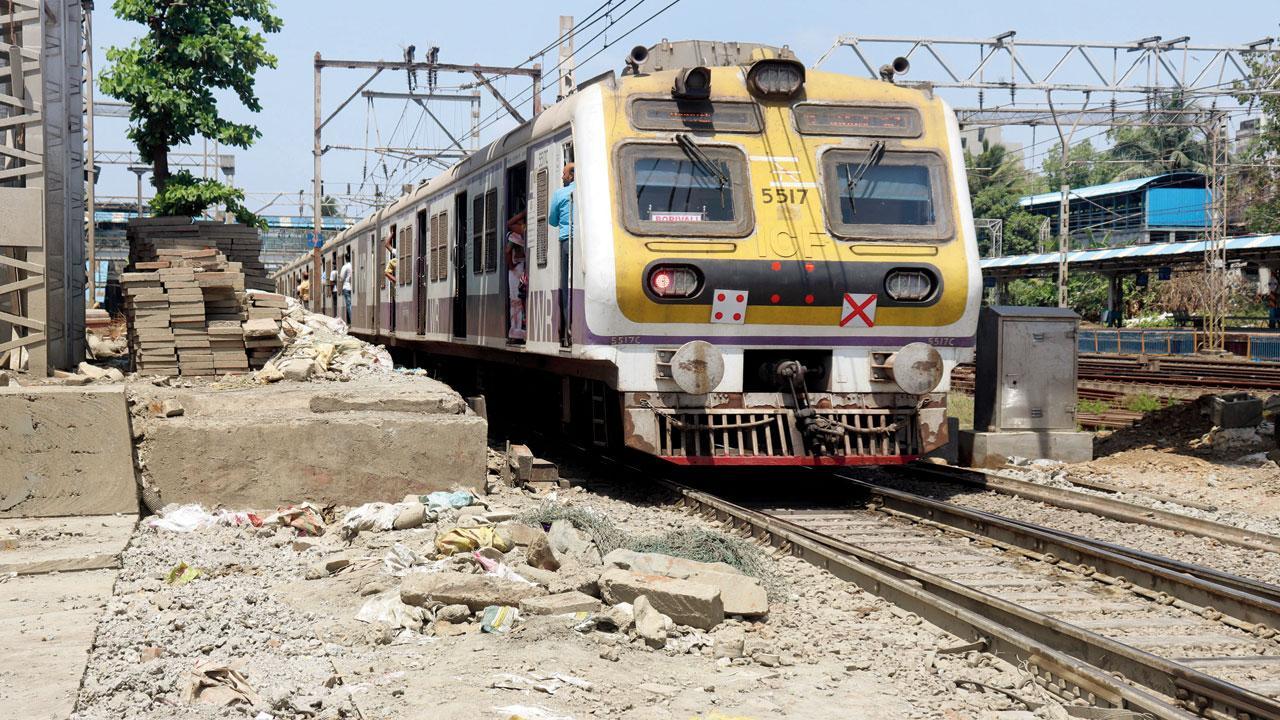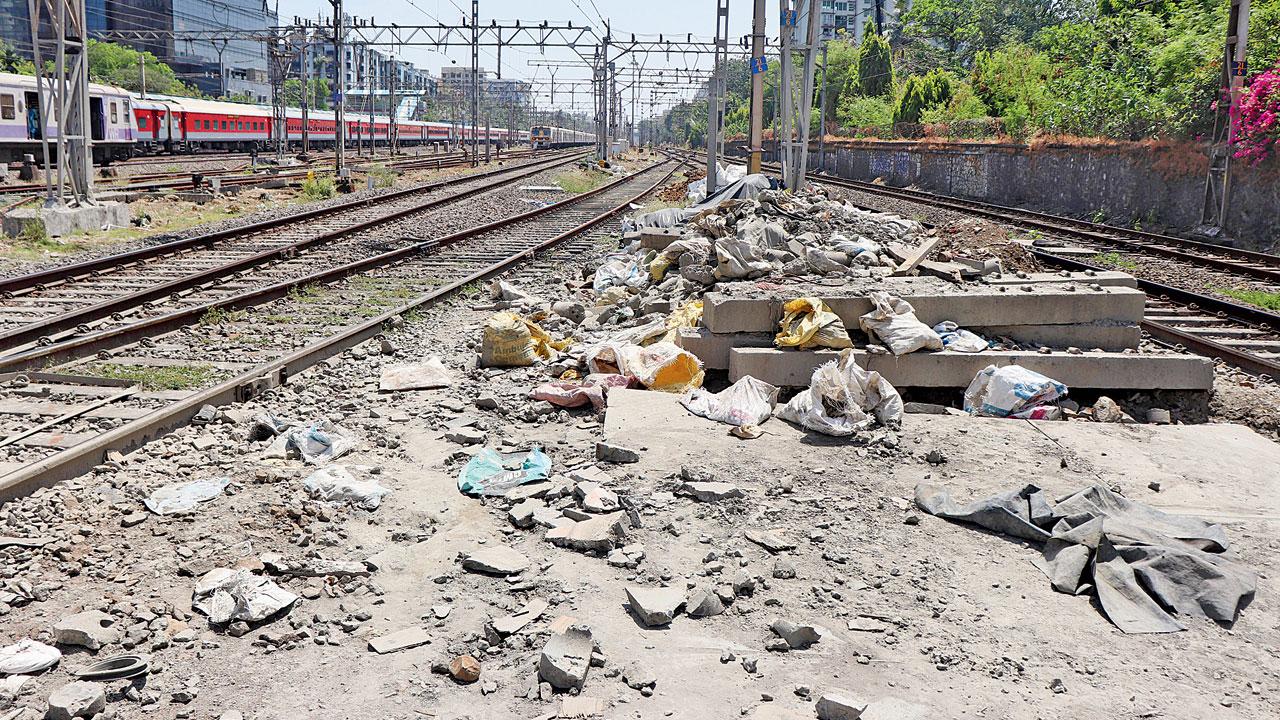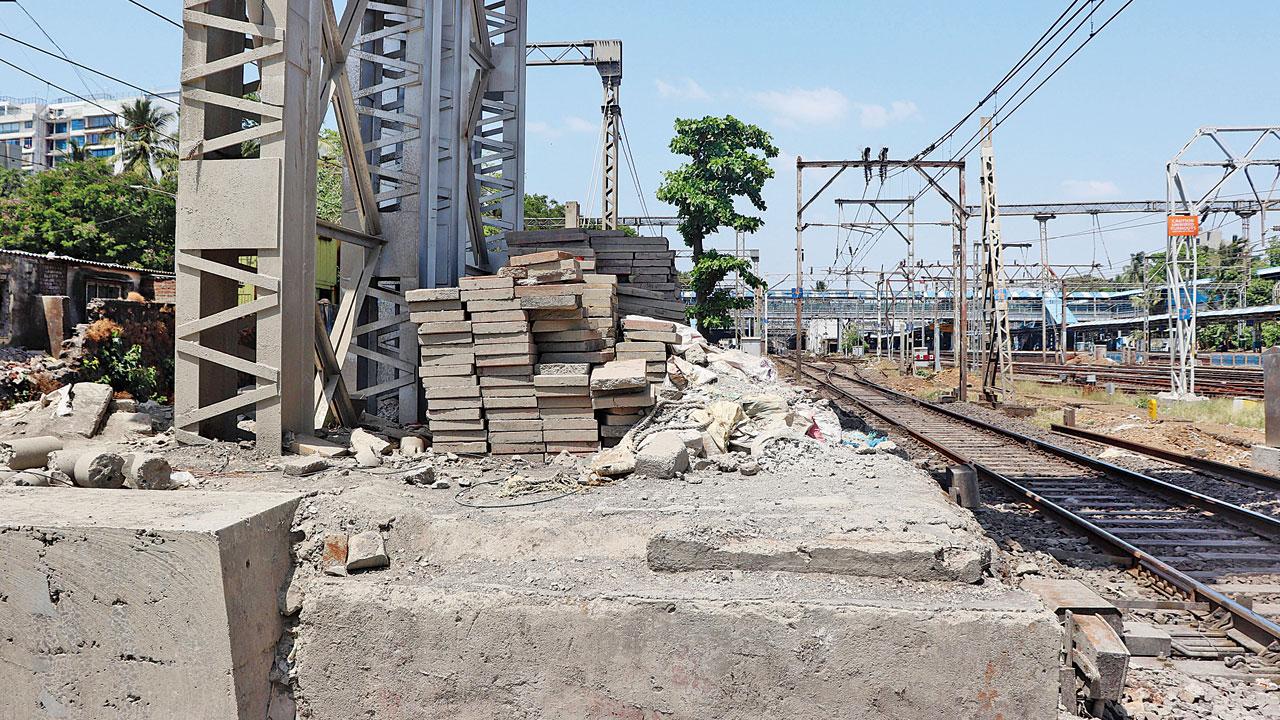Railways somehow finds six to seven night blocks to facilitate piling and foundation work by BMC, which right now looks highly unlikely

Debris from the demolished part of Gokhale bridge next to the tracks at Andheri station. Pics/Anurag Ahire
Western Railway completed demolition of Gokhale bridge at Andheri and the BMC simultaneously started the work of construction, but it appears that the deadline of May 31 for the opening of two lanes of the new bridge rests on ifs and buts. The civic body says this is because, for the work of piling and foundation on railway premises, they need at least six to seven service blocks on the tracks which carry locals and through trains through the day.
ADVERTISEMENT
Gokhale bridge near Andheri railway station closed in the first week of November 2022 after the east side approach to the bridge was found to be dilapidated and dangerous in the structural audit report. The Western Railway (WR) was demolishing part of the bridge on the railway tracks, while the reconstruction is being done by the Brihanmumbai Municipal Corporation (BMC). While a news report earlier said the WR has handed over their portion of the site to BMC, the work of clearing the debris there is on.

“Though the BMC has started some of the work like the tendering process for the new construction, on-site measurements, making of girders and other parts in factories, etc. piling and foundation work cannot be done until we get a time block from the Railways to do it. We are working in coordination with the Railways and are awaiting their response on this,” said an official from the BMC.
Also Read: Western Railway completes dismantling work of Andheri's Gokhale bridge
“The demolition work needed only six blocks but the Railways took three months to complete it as they cannot disrupt the train traffic frequently. They have to make arrangements for lakhs of daily passengers and thousands of interstate passengers. One block on the railway needs approval from at least 30 departments/levels and so it is not easy for them,” said a BMC official. He added that though the BMC will be ready with the supporting work and girders, it will take at least 7 to 8 night blocks to complete the foundation work.

A BMC official said demolition of bridge needed six blocks. File pic/Nimesh Dave
The installation of girders will need a block lasting an entire day just as was needed in the case of Hancock bridge on Central Railway. P Velarasu, additional commissioner, BMC, did not respond to mid-day’s queries.
On February 2, after a visit to Gokhale bridge in Andheri, BMC officials had expressed concern whether they would be able to partially open it by May this year. They had expressed dissatisfaction over the slow progress of the demolition work on the bridge. A meeting with the Railways administration was held on February 7 to speed up the bridge work. The meet was held to help adjust our timeline with their work, said an official.
“No demand for blocks has been put up yet. However all the requisite blocks will duly be given considering their impact on the suburban railway,” said a spokesperson of the Western Railway.
CAG’s observations
The Comptroller and Auditor General of India (CAG) Audit recently observed that even after the serious incident of collapse of part of Gokhale bridge in July 2018 and recommendations of the structural auditor, the civic body did not plan for reconstruction of the bridge in a timely manner. The CAG, in its report, clearly mentioned that the reconstruction of the Gokhale bridge was delayed by almost four years.

Debris from bridge has been lying uncleared at Andheri station. Pic/Anurag Ahire
Scrutiny of records revealed that against the targeted physical progress of 75 per cent up to October 31, 2022, the contractor (SMS Infrastructure Limited) had achieved physical progress of 15 per cent (December 2022). Among its observations, the report further mentioned that it was also noticed that there was a lack of co-ordination between Western Railway and BMC as it took more than 24 months to arrive at a decision on the minimum height of the proposed girder from the highest Rail Track Level (RTL). Consequently, the contractor had not executed the works as per the targeted milestones. Any action taken by the BMC to prioritise the work was not on record.
The chief engineer, bridges, stated (January 2023) that the slow progress of the work was due to various reasons such as COVID-19, delay in issue of Traffic Police NOC and design changes and, if required, extension would be granted to the contractor. The BMC stated (March 2023) that delay in approval of General Arrangement Drawing (GAD) by Western Railway Authority led to delays. The CAG report mentioned that the reply of the chief engineer, bridges, is not tenable as other than periodic disruptions, after the initial phase of Covid -19 lockdowns, the work should have been planned to be executed in a timely manner, which was not done. Further, better coordination with the WR was required for timely completion of the project, the primary responsibility for which was with the BMC.
 Subscribe today by clicking the link and stay updated with the latest news!" Click here!
Subscribe today by clicking the link and stay updated with the latest news!" Click here!







